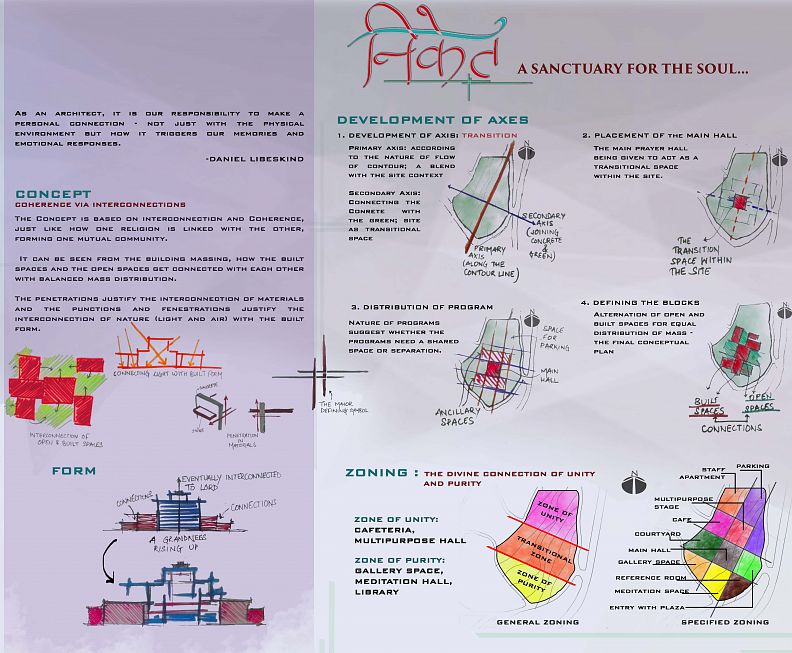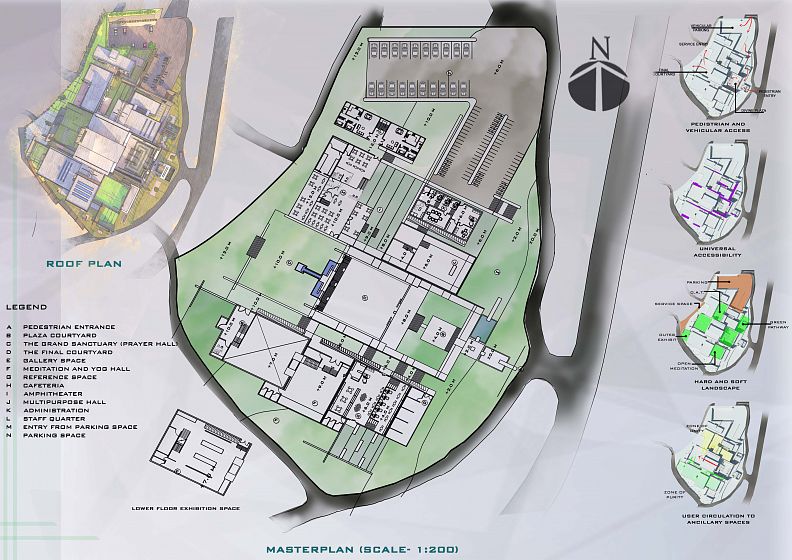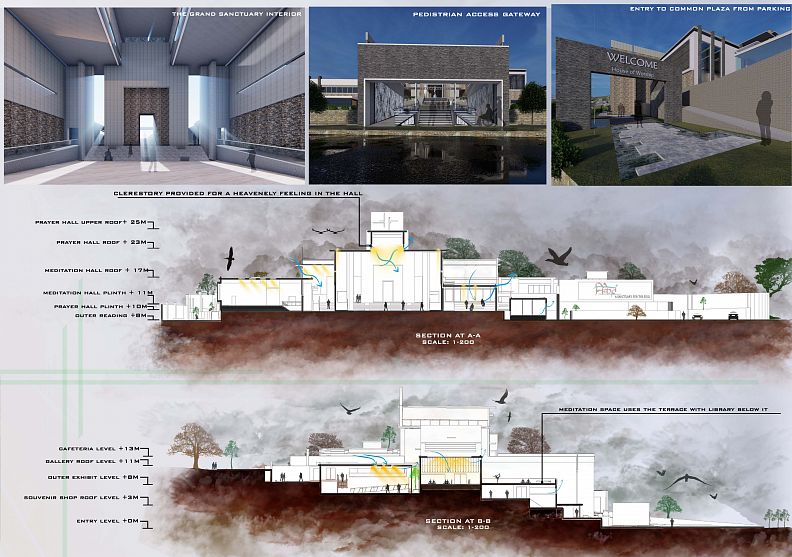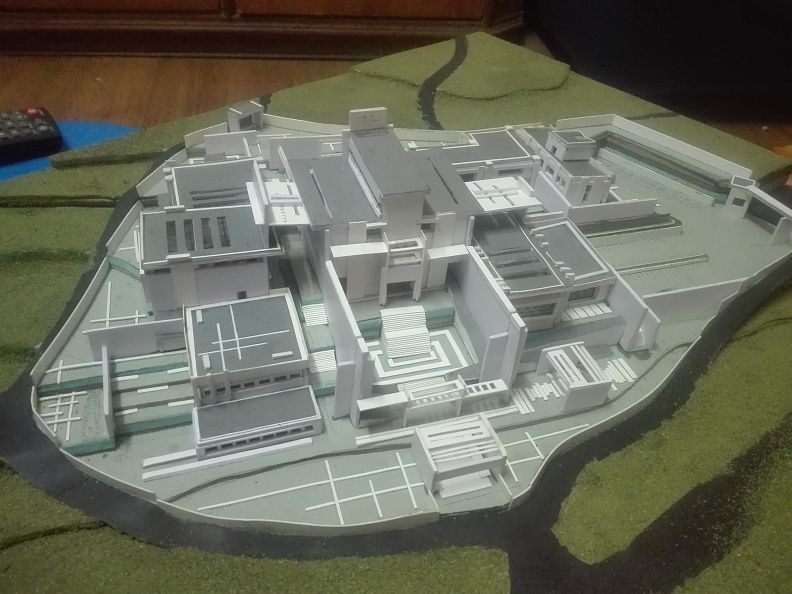निकेत - House of Worship

Project idea
House of Worship is the place where people of various religious backgrounds gather to offer their prayers and worship by remembering God in the same place and in their own ways. The major idea of the structure is to bring religious harmony within a place where people are characterized on the basis of religion, culture and social norms. The lifestyle around the Kathmandu valley is developing with time but when it comes to religious aspects, it seems very important to bring the mindset of people to a common level. This way, they can feel the importance of each other’s religion, respect it and move together. This project also aims to establish an important religious landmark that serves on the peaceful south-western portion of the Valley.
Project description
The project House of Worship is one of those projects which aims to bring a small revolution regarding the religious tolerance among the people in the Kathmandu Valley. Since the site is situated at the south-western portion of the valley, just beyond the outskirts, it has a wonderful surrounding that comprehends both the nature and concrete. Both green and grey are a part of the whole vista seen from the site and thus the aspects of nature and concrete has been tried to be incorporated in this design.
The site is 8059.01 sq. m. that is oriented along north-south. The north-east portion of the site consists of dense settlement and the south-east consists of untouched nature. Similarly, the site consists of a monastery and a shrine of goddess Manjushree, both being a sign of attempt to maintain religious harmony in that area. This house of worship aimed to add to that attempt. The site consisted of growing contours from east to west and the main access road at the east, the site looked welcoming from the main road.
Taking all these into consideration, the conceptual development was started. The concept of this House of Worship is “Coherence Via Interconnection”. The concept is based on the coherence and interconnection, just like how one religion is connected with the other somehow. The fact that the preaches from Christianity is also followed by Buddhism, the things written in Q’uran from Islam religion is also followed in Hindu book Bhagwad Gita. Various connections are there among religions. The same concept has been tried to incorporate within the building. The building massing shows how the built and the open spaces get connected with each other with balanced mass distribution. Similarly, various penetrations justify the interconnection of materials, the traditional stone material and the modern concrete. The fenestration also show the connection of nature (air, light, water) with the built form as a whole. The whole complex is then given a form such that the central structure seems to be rising up towards the sky and paying respect to the one God, Light!
For the programs to be distributed, the initial phase was the development of axes. The primary axis is the one that goes along with the flow of contour, along north-south. This axis blends with the site context. The secondary axis that went across the site from east to west was the axis to connect the concrete and the green. The site acts as the central connecting/ transitional space to connect those aspects. At the intersection of both the axes, is the area for the placement of hall. The hall acts as the transitional space itself. Then, going further, there nature of program was seen if they need a shared space or separation. Finally, the blocks were defined taking zoning into consideration. Zones were generally divided as the zone of unity (spaces where people unite and interact) and the zone of purity (spaces consisting of purity of knowledge) further spaces were divided and as per specific zoning and the will to give connections of open and built spaces, the masterplan was further developed.
Technical information
The masterplan consists of a central main hall that has a big courtyard to welcome the visitors/pilgrims. Major entry from east brings in pedestrians and the vehicular entry from north gives space for parking 19 cars and 75 motorcycles. From the parking, the path takes towards the admin section and down towards the small junction point from both north and east. While going towards the junction, smaller gateways are given so as to gradually bring in the infinite scale down to human scale.
This takes the user to the Plaza courtyard which is a big courtyard and the hall situated 4m above the courtyard. This acts as the plinth for the hall that defines its grandness, just like the temple of Hatshepshut in Egypt. How the raising of height gives a sense of grandeur and makes the visitor feel special while climbing the stairs to the hall. Another design aspect is the huge embracing walls at the sides of the hall. This is to create a focus to the visitors while they come in for prayers and not get deluded by any other spaces at the beginning. After entering the Grand Sanctuary (निकेत), the prayer hall (caters 100 people), this place has a touch of natural lights from slits cut on the walls. The big hall is positioned such that the light from straight above, from clerestory and the fenestrations are uniformly penetrated throughout the day inside the hall. Since this hall serves for all religions, thus no shrines or statues are left here. The common God people will pray to shall be Light.
After the prayers are done according to the respective religion, they attain a higher level of spirituality and that is when the final courtyard comes into pay. The courtyard is placed at another 2m higher contour, signifying a higher level of spirituality. People with that level of mindset interact with each other in the courtyard and from there, the choice of the visitor is free, where to exit from the eastern end or to turn towards the one of unity or towards the zone of purity.
The zone of unity consists of café space at the northern side which adds to the self-sustaining feature of the whole complex. The outer dining spaces help to connect with other spaces such as the amphitheater that overlooks the multipurpose hall. This semi-covered multipurpose hall consists of various dramas, plays, rituals to be performed where one religion can know about the values and rituals of the other religion. The unity is thus achieved here. Other smaller spaces are the administrative block of the complex for about 7-10 workers and the staff quarter for 5 families.
The zone of purity is situated at the southern side where the sound pollution is the least. The block on the topmost contour beside the final courtyard is the mezzanine gallery space where things related to various religions are exhibited. Outdoor galley is also provided for any temporary exhibits. Going further below the contour, the meditation hall is there adjacent to the gallery. The most amazing part of the two blocks is the central plantation that is situated between the two blocks, visible from either side. The gallery tends to exhibit the life of nature, growth of a tree and the meditation hall tends to symbolize the spirituality of nature by a holy plant. The meditation hall caters 50 people and the outdoor meditation space is also there that consists of a roof garden. The block that has the roof garden actually is a library where various religion-related books are kept and space for e-library is also provided within. Library opens towards the further south for open space to read outside in peace. Small Zen gardens increase the value of the area. Finally, at the bottom most contour, there is a souvenir shop that users indulge into after seeing all the aspects related to religion in the House of Worship.
The sections show how the lights penetrate various surfaces and provide proper natural lighting in various spaces. Also, the roof garden helps to maintain the atmosphere of the library and meditation hall intact. Various landscaping elements tend to symbolize the overall symbol of the complex. The southern road is used for services and the major services are provided in the staff apartment, restaurant and exhibition spaces. Universal design is given equal priority with various ramps and tactile flooring.













